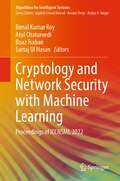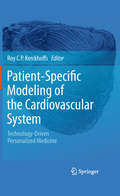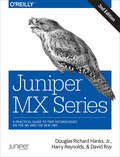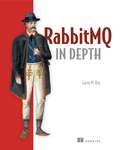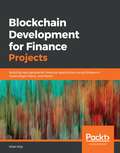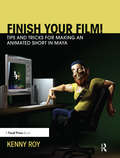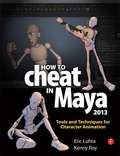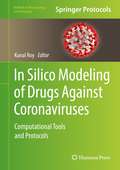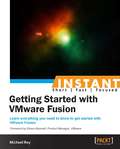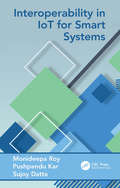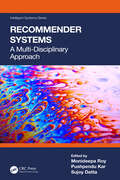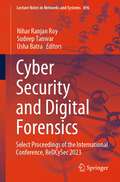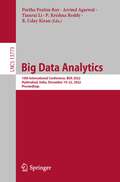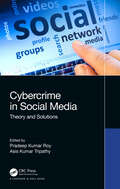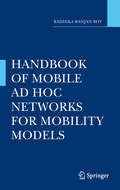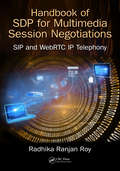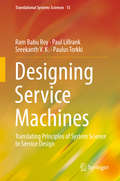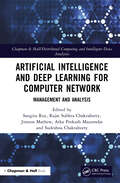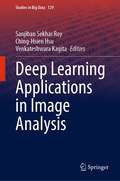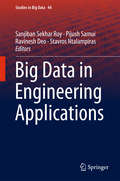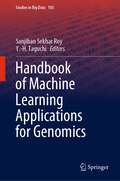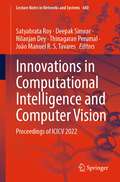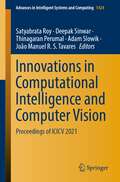- Table View
- List View
Cryptology and Network Security with Machine Learning: Proceedings of ICCNSML 2022 (Algorithms for Intelligent Systems)
by Bimal Kumar Roy Atul Chaturvedi Boaz Tsaban Sartaj Ul HasanThe book features original papers from International Conference on Cryptology & Network Security with Machine Learning (ICCNSML 2022), organized by PSIT, Kanpur, India during 16 – 18 December 2022. This conference proceeding will provide the understanding of core concepts of Cryptology & Network Security with ML in data communication. The book covers research papers in public key cryptography, elliptic curve cryptography, post quantum cryptography, lattice based cryptography, non-commutative ring based cryptography, cryptocurrency, authentication, key agreement, Hash functions, block/stream ciphers, polynomial based cryptography, code based cryptography, NTRU cryptosystems, security and privacy in machine learning, block chain, IoT security, wireless security protocols, cryptanalysis, number theory, quantum computing, cryptographic aspects of network security, complexity theory, and cryptography with machine learning.
Patient-Specific Modeling of the Cardiovascular System
by Roy C.P. KerckhoffsThe main purpose of the book is to demonstrate the design of a variety of patient-specific models within the cardiovascular system in computational biology. The maturation of computational biology could lead to a new approach to medicine. During the last five to ten years, there have been many improvements in diagnostic medical technologies such as multi-slice cardiac CT imaging, 3-D electroanatomic mapping, and many types of applications of Magnetic Resonance Imaging (i.e. magnetic resonance tagging and diffusion tensor imaging). Combined with more powerful computing resources and more accurate predictive computational models it is feasible to begin developing mechanistic patient-specific models that may help diagnosis, guide therapy or surgery, and predict outcomes of the latter. Many questions need to be answered before computational modeling can be fully integrated with standard care, such as what is the minimal data set needed from the patient in order to build a reliable predictive model? What accuracy is needed? How will the initial baseline model be validated? What are reasonable computation times? Is some type of perturbation of the patient's physiology necessary? How could they be integrated with current practices? Are physicians willing to accept these models? These questions will also serve as guidelines throughout the chapters. The book will try to cover, such as cardiac electrophysiology, cardiac (muscle) mechanics, circulation dynamics, arterial and venous flow, angiogenesis, remodeling, metabolism, or combinations between these such as cardiac electromechanics or fluid-solid interactions.
Juniper MX Series: A Comprehensive Guide to Trio Technologies on the MX
by David Roy Harry Reynolds Douglas Richard Hanks Jr.Discover why routers in the Juniper MX Series--with their advanced feature sets and record-breaking scale--are so popular among enterprises and network service providers. This revised and expanded edition shows you step-by-step how to implement high-density, high-speed Layer 2 and Layer 3 Ethernet services, using Router Engine DDoS Protection, Multi-chassis LAG, Inline NAT, IPFLOW, and many other Juniper MX features.This second edition was written by a Senior NOC engineer, whose vast experience with the MX Series is well documented. Each chapter covers a specific Juniper MX vertical and includes review questions to help you test what you've learned. This edition includes new chapters on load balancing and vMX--Juniper MX's virtual instance.Work with Juniper MX's bridging, VLAN mapping, and support for thousands of virtual switchesExamine Juniper MX high-availability features and protocolsUse Trio Chipset's load balancing features for different types of trafficExplore the benefits and typical use cases of vMXAdd an extra layer of security with Junos DDoS protectionCreate a firewall filter framework that applies filters specific to your networkDiscover the advantages of hierarchical schedulingCombine Juniper MX routers, using a virtual chassis or Multi-chassis LAGInstall network services such as Network Address Translation (NAT)
RabbitMQ in Depth
by Gavin M. RoySummaryRabbitMQ in Depth is a practical guide to building and maintaining message-based applications. This book provides detailed coverage of RabbitMQ with an emphasis on why it works the way it does.Purchase of the print book includes a free eBook in PDF, Kindle, and ePub formats from Manning Publications.About the TechnologyAt the heart of most modern distributed applications is a queue that buffers, prioritizes, and routes message traffic. RabbitMQ is a high-performance message broker based on the Advanced Message Queueing Protocol. It?s battle tested, ultrafast, and powerful enough to handle anything you can throw at it. It requires a few simple setup steps, and you can instantly start using it to manage low-level service communication, application integration, and distributed system message routing.About the BookRabbitMQ in Depth is a practical guide to building and maintaining message-based applications. This book provides detailed coverage of RabbitMQ with an emphasis on why it works the way it does. You'll find examples and detailed explanations based in real-world systems ranging from simple networked services to complex distributed designs. You'll also find the insights you need to make core architectural choices and develop procedures for effective operational management. What's InsideAMQP, the Advanced Message Queueing ProtocolCommunicating via MQTT, Stomp, and HTTPValuable troubleshooting techniquesDatabase integrationAbout the ReaderWritten for programmers with a basic understanding of messaging-oriented systems.About the AuthorGavin M. Roy is an active, open source evangelist and advocate who has been working with internet and enterprise technologies since the mid-90s. Technical editor James Titcumb is a freelance developer, trainer, speaker, and active contributor to open source projects.Table of ContentsPART 1 - RABBITMQ AND APPLICATION ARCHITECTUREFoundational RabbitMQ How to speak Rabbit: the AMQ Protocol An in-depth tour of message properties Performance trade-offs in publishing Don't get messages; consume them Message patterns via exchange routing PART 2 - MANAGING RABBITMQ IN THE DATA CENTER OR THE CLOUDScaling RabbitMQ with clusters Cross-cluster message distribution PART 3 - INTEGRATIONS AND CUSTOMIZATIONUsing alternative protocols Database integrations
Blockchain Development for Finance Projects: Building next-generation financial applications using Ethereum, Hyperledger Fabric, and Stellar
by Ishan RoyA practical blockchain handbook designed to take you through implementing and re-engineering banking and financial solutions and workflows using eight step-by-step projects Key Features Implement various end-to-end blockchain projects and learn to enhance present-day financial solutions Use Ethereum, Hyperledger, and Stellar to build public and private decentralized applications Address complex challenges faced in the BFSI domain using different blockchain platform services Book Description Blockchain technology will continue to play an integral role in the banking and finance sector in the coming years. It will enable enterprises to build transparent and secure business processes. Experts estimate annual savings of up to 20 billion dollars from this technology. This book will help you build financial apps using blockchain, guiding you through enhancing popular products and services in the banking and finance sector. The book starts by explaining the essential concepts of blockchain, and the impact of blockchain technology on the BFSI sector. Next, you'll delve into re-designing existing banking processes and building new financial apps using blockchain. To accomplish this, you'll work through eight blockchain projects. By demonstrating the entire process, the book helps you understand everything from setting up the environment and building frontend portals to system integration and testing apps. You will gain hands-on experience with the Ethereum, Hyperledger Fabric, and Stellar to develop private and public decentralized apps. Finally, you'll learn how to use ancillary platforms and frameworks such as IPFS, Truffle OpenZeppelin, and MetaMask. By the end of this blockchain book, you'll have an in-depth understanding of how to leverage distributed ledgers and smart contracts for financial use cases. What you will learn Design and implement blockchain solutions in a BFSI organization Explore common architectures and implementation models for enterprise blockchain Design blockchain wallets for multi-purpose applications using Ethereum Build secure and fast decentralized trading ecosystems with Blockchain Implement smart contracts to build secure process workflows in Ethereum and Hyperledger Fabric Use the Stellar platform to build KYC and AML-compliant remittance workflows Map complex business workflows and automate backend processes in a blockchain architecture Who this book is for This book is for blockchain and Dapps developers, or anyone looking for a guide to building innovative and highly secure solutions in the fintech domain using real-world use cases. Developers working in financial enterprises and banks, and solution architects looking to build brand new process flows using blockchain technology will also find the book useful. Experience with Solidity programming and prior knowledge of finance and trade are required to get the most out of this book.
Finish Your Film! Tips and Tricks for Making an Animated Short in Maya: Tips And Tricks For Making An Animated Short In Maya
by Kenny RoyFinish Your Film! Tips and Tricks for Making an Animated Short in Maya is a first-of-its-kind book that walks the reader step-by-step through the actual production processes of creating a 3D Short film with Maya. Other books focus solely on the creative decisions of 3D Animation and broadly cover the multiple phases of animation production with no real applicable methods for readers to employ. This book shows you how to successfully manage the entire Maya animation pipeline. This book blends together valuable technical tips on film production and real-world shortcuts in a step-by-step approach to make sure you do not get lost. Follow along with author and director Kenny Roy as he creates a short film in front of your eyes using the exact same methods he shows you in the book. Armed with this book, you'll be able to charge forth into the challenge of creating a short film, confident that creativity will show up on screen instead of being stifled by the labyrinth that is a 3D animation pipeline.
How to Cheat in Maya 2014: Tools and Techniques for Character Animation
by Kenny RoyAll professional animators know a handful of secrets that give them an edge in a production environment. "How to Cheat in Maya" puts these secrets in your hands! Learn time and energy-saving techniques tested in real Hollywood productions in this book, jam-packed with screenshots and scene files designed to get you up to speed quickly. <P><P>From menus to modeling, lipsync to lighting, How to Cheat in Maya 2014 covers all of the methods available in the latest version of Maya. Get up to speed quickly and produce stellar results with these insider workflows. With new, updated cheats for the latest version of Maya, How to Cheat in Maya 2014 is an essential guide for amateur and professional 3D animators alike. Fully updated with gold-mine coverage including: expanded sections on production workflow, all new chapters covering rigging cheats and Maya's referencing tools, and brand new project files demonstrating production-proven techniques. <P><P>The companion website includes complete scene files for exercises and techniques, extra rigs, Quicktime movies of full projects, and video tutorials.
How to Cheat in Maya 2013: Tools and Techniques for Character Animation
by Kenny Roy Eric LuhtaAll professional animators know a handful of secrets that give them an edge in a production environment. "How to Cheat in Maya" puts these secrets in your hands! Learn time and energy saving techniques tested in real Hollywood productions in this book, jam-packed with screenshots and scene files designed to get you up to speed quickly. From menus to modeling, lipsync to lighting, How to Cheat in Maya 2013 covers all of the methods available in the latest version of Maya. Get up to speed quickly and produce stellar results with these insider workflows. With new, updated cheats for the latest version of Maya, "How to Cheat in Maya" is an essential guide for amateur and professional 3D animators alike. Fulyl updated with gold-mine coverage including: expanded sections on production workflow, all new chapters covering rigging cheats and Maya's referencing tools, and brand new project files demonstrating production-proven techniques. The companion website includes complete scene files for exercises and techniques, extra rigs, Quicktime movies of full projects, and video tutorials.
In Silico Modeling of Drugs Against Coronaviruses: Computational Tools and Protocols (Methods in Pharmacology and Toxicology)
by Kunal RoyThis essential volume explores a variety of tools and protocols of structure-based (homology modeling, molecular docking, molecular dynamics, protein-protein interaction network) and ligand-based (pharmacophore mapping, quantitative structure-activity relationships or QSARs) drug design for ranking and prioritization of candidate molecules in search of effective treatment strategy against coronaviruses. Beginning with an introductory section that discusses coronavirus interactions with humanity and COVID-19 in particular, the book then continues with sections on tools and methodologies, literature reports and case studies, as well as online tools and databases that can be used for computational anti-coronavirus drug research. Written for the Methods in Pharmacology and Toxicology series, chapters include the kind of practical detail and implementation advice that ensures high quality results in the lab. Comprehensive and timely, In Silico Modeling of Drugs Against Coronaviruses: Computational Tools and Protocols is an ideal reference for researchers working on the development of novel anti-coronavirus drugs for SARS-CoV-2 and for coronaviruses that will likely appear in the future.
Instant Getting Started with VMware Fusion
by Michael RoyThis book is a hands-on, practical guide that will help readers to understand the various capabilities of VMware Fusion with the help of real-world examples. This book is a must for every Mac user out there who is in the process of transitioning from Windows to OS X. Whether you're new to Fusion or you've been using it for years, there's something new for everyone to learn.
Interoperability in IoT for Smart Systems (Intelligent Systems)
by Monideepa Roy Pushpendu Kar Sujoy DattaInteroperability in IoT for Smart Systems discusses the different facets of interoperability issues among the IoT devices and their solutions, the scalability issues in an IoT network, and provides solutions for plug-n-play of new devices with the existing IoT system. It also addresses the possible usage of interoperable and plug-n-play IoT networks in different systems to make them smarter. Aimed at researchers and graduate students in computer science, computer engineering, computer networks, electronics engineering, this book Exclusively covers interoperability of IoT systems in parallel with their use towards the development of smart systems Discusses the requirements of interoperability in smart IoT systems and their solutions Reviews IoT applications in different smart and intelligent systems Explores dealing with interoperability of heterogeneous participating devices Provides different case studies and open problems related to interoperability in IoT systems
Recommender Systems: A Multi-Disciplinary Approach (Intelligent Systems)
by Monideepa Roy Pushpendu Kar Sujoy DattaRecommender Systems: A Multi-Disciplinary Approach presents a multi-disciplinary approach for the development of recommender systems. It explains different types of pertinent algorithms with their comparative analysis and their role for different applications. This book explains the big data behind recommender systems, the marketing benefits, how to make good decision support systems, the role of machine learning and artificial networks, and the statistical models with two case studies. It shows how to design attack resistant and trust-centric recommender systems for applications dealing with sensitive data. Features of this book: Identifies and describes recommender systems for practical uses Describes how to design, train, and evaluate a recommendation algorithm Explains migration from a recommendation model to a live system with users Describes utilization of the data collected from a recommender system to understand the user preferences Addresses the security aspects and ways to deal with possible attacks to build a robust system This book is aimed at researchers and graduate students in computer science, electronics and communication engineering, mathematical science, and data science.
Cyber Security and Digital Forensics: Select Proceedings of the International Conference, ReDCySec 2023 (Lecture Notes in Networks and Systems #896)
by Nihar Ranjan Roy Sudeep Tanwar Usha BatraThe book contains peer-reviewed papers from the International Conference on Recent Developments in Cyber Security organized by the Center for Cyber Security and Cryptology at Sharda University in June 2023. This volume focuses on privacy and secrecy of information, cryptography, applications and analysis, cyber threat intelligence and mitigation, cyber-physical systems, cyber threat intelligence, quantum cryptography and blockchain technologies and their application, etc. This book is a unique collection of chapters from different areas with a common theme and will be immensely useful to academic researchers and practitioners in the industry.
Dynamic Formal Epistemology
by Olivier Roy Patrick Girard Mathieu MarionThis volume is a collation of original contributions from the key actors of a new trend in the contemporary theory of knowledge and belief, that we call "dynamic epistemology". It brings the works of these researchers under a single umbrella by highlighting the coherence of their current themes, and by establishing connections between topics that, up until now, have been investigated independently. It also illustrates how the new analytical toolbox unveils questions about the theory of knowledge, belief, preference, action, and rationality, in a number of central axes in dynamic epistemology: temporal, social, probabilistic and even deontic dynamics.
Big Data Analytics: 10th International Conference, BDA 2022, Hyderabad, India, December 19–22, 2022, Proceedings (Lecture Notes in Computer Science #13773)
by Partha Pratim Roy Arvind Agarwal Tianrui Li P. Krishna Reddy R. Uday KiranThis book constitutes the proceedings of the 10th International Conference on Big Data Analytics, BDA 2022, which took place in Hyderabad, India, in December 2022.The 7 full papers and 7 short papers presented in this volume were carefully reviewed and selected from 36 submissions. The book also contains 4 keynote talks in full-paper length. The papers are organized in the following topical sections: Big Data Analytics: Vision and Perspectives; Data Science: Architectures; Data Science: Applications; Graph Analytics; Pattern Mining; Predictive Analytics in Agriculture.
Cybercrime in Social Media: Theory and Solutions
by Pradeep Kumar Roy Asis Kumar TripathyThis reference text presents the important components for grasping the potential of social computing with an emphasis on concerns, challenges, and benefits of the social platform in depth. Features: Detailed discussion on social-cyber issues, including hate speech, cyberbullying, and others Discusses usefulness of social platforms for societal needs Includes framework to address the social issues with their implementations Covers fake news and rumor detection models Describes sentimental analysis of social posts with advanced learning techniques The book is ideal for undergraduate, postgraduate, and research students who want to learn about the issues, challenges, and solutions of social platforms in depth.
Handbook of Mobile Ad Hoc Networks for Mobility Models
by Radhika Ranjan RoyThe Mobile Ad Hoc Network (MANET) has emerged as the next frontier for wireless communications networking in both the military and commercial arena. Handbook of Mobile Ad Hoc Networks for Mobility Models introduces 40 different major mobility models along with numerous associate mobility models to be used in a variety of MANET networking environments in the ground, air, space, and/or under water mobile vehicles and/or handheld devices. These vehicles include cars, armors, ships, under-sea vehicles, manned and unmanned airborne vehicles, spacecrafts and more. This handbook also describes how each mobility pattern affects the MANET performance from physical to application layer; such as throughput capacity, delay, jitter, packet loss and packet delivery ratio, longevity of route, route overhead, reliability, and survivability. Case studies, examples, and exercises are provided throughout the book. Handbook of Mobile Ad Hoc Networks for Mobility Models is for advanced-level students and researchers concentrating on electrical engineering and computer science within wireless technology. Industry professionals working in the areas of mobile ad hoc networks, communications engineering, military establishments engaged in communications engineering, equipment manufacturers who are designing radios, mobile wireless routers, wireless local area networks, and mobile ad hoc network equipment will find this book useful as well.
Handbook of SDP for Multimedia Session Negotiations: SIP and WebRTC IP Telephony
by Radhika Ranjan RoyThis book on SDP is the first of this kind that attempts to put all SDP related RFCs together with their mandatory and optional texts in a chronological systematic way as if people can use a single “super-SDP RFC” with almost one-to-one integrity from beginning to end to see the big picture of SDP in addition to base SDP functionalities.
Designing Service Machines: Translating Principles of System Science to Service Design (Translational Systems Sciences #15)
by Ram Babu Roy Paul Lillrank Sreekanth V. K. Paulus TorkkiThis book presents a general conceptual framework to translate principles of system science and engineering to service design. Services are co-created immaterial, heterogeneous, and perishable state changes. A service system includes the intended benefit to the customer and the structure and processes that accomplish this benefit. The primary focus is on the part of the service system that can reproduce such processes, called here a Service Machine, and methodological guidelines on how to analyze and design them. While the benefit and the process are designed based on the domain knowledge of each respective field, service production systems have common properties. The Service Machine is a metaphor that elicits the fundamental characteristics of service systems that do something efficiently, quickly, or repeatedly for a defined end. A machine is an artifact designed for a purpose, has several parts, such as inputs, energy flows, processors, connectors, and motors assembled as per design specifications. In case of service machine, the components are various contracts assembled on contractual frames. The book discusses Emergency Medical Services (EMS) and Emergency Departments (ED) as cases. They illustrate that service machines need to be structured to adapt to the constraints of the served market acknowledging the fact that services are co-created through the integration of producers’ and customers’ resources. This book is highly recommended for those who are interested in understanding the fundamental concepts of designing service machines.
Artificial Intelligence and Deep Learning for Computer Network: Management and Analysis (Chapman & Hall/Distributed Computing and Intelligent Data Analytics)
by Sangita Roy Rajat Subhra Chakraborty Jimson Mathew Arka Prokash Mazumdar Sudeshna ChakrabortyArtificial Intelligence and Deep Learning for Computer Network: Management and Analysis aims to systematically collect quality research spanning AI, ML, and deep learning (DL) applications to diverse sub-topics of computer networks, communications, and security, under a single cover. It also aspires to provide more insights on the applicability of the theoretical similitudes, otherwise a rarity in many such books. Features: A diverse collection of important and cutting-edge topics covered in a single volume. Several chapters on cybersecurity, an extremely active research area. Recent research results from leading researchers and some pointers to future advancements in methodology. Detailed experimental results obtained from standard data sets. This book serves as a valuable reference book for students, researchers, and practitioners who wish to study and get acquainted with the application of cutting-edge AI, ML, and DL techniques to network management and cyber security.
Deep Learning Applications in Image Analysis (Studies in Big Data #129)
by Sanjiban Sekhar Roy Ching-Hsien Hsu Venkateshwara KagitaThis book provides state-of-the-art coverage of deep learning applications in image analysis. The book demonstrates various deep learning algorithms that can offer practical solutions for various image-related problems; also how these algorithms are used by scientists and scholars in industry and academia. This includes autoencoder and deep convolutional generative adversarial network in improving classification performance of Bangla handwritten characters, dealing with deep learning-based approaches using feature selection methods for automatic diagnosis of covid-19 disease from x-ray images, imbalance image data sets of classification, image captioning using deep transfer learning, developing a vehicle over speed detection system, creating an intelligent system for video-based proximity analysis, building a melanoma cancer detection system using deep learning, plant diseases classification using AlexNet, dealing with hyperspectral images using deep learning, chest x-ray image classification of pneumonia disease using efficient net and inceptionv3.The book also addresses the difficulty of implementing deep learning in terms of computation time and the complexity of reasoning and modelling different types of data where information is currently encoded. Each chapter has the application of various new or existing deep learning models such as Deep Neural Network (DNN) and Deep Convolutional Neural Networks (DCNN). The detailed utilization of deep learning packages that are available in MATLAB, Python and R programming environments have also been discussed, therefore, the readers will get to know about the practical implementation of deep learning as well. The content of this book is presented in a simple and lucid style for professionals, nonprofessionals, scientists, and students interested in the research area of deep learning applications in image analysis.
Big Data in Engineering Applications (Studies in Big Data #44)
by Sanjiban Sekhar Roy Pijush Samui Ravinesh Deo Stavros NtalampirasThis book presents the current trends, technologies, and challenges in Big Data in the diversified field of engineering and sciences. It covers the applications of Big Data ranging from conventional fields of mechanical engineering, civil engineering to electronics, electrical, and computer science to areas in pharmaceutical and biological sciences. This book consists of contributions from various authors from all sectors of academia and industries, demonstrating the imperative application of Big Data for the decision-making process in sectors where the volume, variety, and velocity of information keep increasing. The book is a useful reference for graduate students, researchers and scientists interested in exploring the potential of Big Data in the application of engineering areas.
Handbook of Machine Learning Applications for Genomics (Studies in Big Data #103)
by Sanjiban Sekhar Roy Y. H. TaguchiCurrently, machine learning is playing a pivotal role in the progress of genomics. The applications of machine learning are helping all to understand the emerging trends and the future scope of genomics. This book provides comprehensive coverage of machine learning applications such as DNN, CNN, and RNN, for predicting the sequence of DNA and RNA binding proteins, expression of the gene, and splicing control. In addition, the book addresses the effect of multiomics data analysis of cancers using tensor decomposition, machine learning techniques for protein engineering, CNN applications on genomics, challenges of long noncoding RNAs in human disease diagnosis, and how machine learning can be used as a tool to shape the future of medicine. More importantly, it gives a comparative analysis and validates the outcomes of machine learning methods on genomic data to the functional laboratory tests or by formal clinical assessment. The topics of this book will cater interest to academicians, practitioners working in the field of functional genomics, and machine learning. Also, this book shall guide comprehensively the graduate, postgraduates, and Ph.D. scholars working in these fields.
Innovations in Computational Intelligence and Computer Vision: Proceedings of ICICV 2022 (Lecture Notes in Networks and Systems #680)
by Satyabrata Roy Deepak Sinwar Nilanjan Dey Thinagaran Perumal João Manuel R. S. TavaresThis book presents high-quality, peer-reviewed papers from the International Conference on “Innovations in Computational Intelligence and Computer Vision (ICICV 2022),” hosted by Manipal University Jaipur, Rajasthan, India, on 24–25 November 2022. The book includes a collection of innovative ideas from researchers, scientists, academics, industry professionals and students. The book covers a variety of topics, such as artificial intelligence and computer vision, image processing and video analysis, applications and services of artificial intelligence and computer vision, interdisciplinary areas combining artificial intelligence and computer vision, and other innovative practices.
Innovations in Computational Intelligence and Computer Vision: Proceedings of ICICV 2021 (Advances in Intelligent Systems and Computing #1424)
by Satyabrata Roy Deepak Sinwar Thinagaran Perumal Adam Slowik João Manuel R. S. TavaresThis book presents high-quality, peer-reviewed papers from the International Conference on “Innovations in Computational Intelligence and Computer Vision (ICICV 2021),” hosted by Manipal University Jaipur, Rajasthan, India, on August 5–6, 2021. Offering a collection of innovative ideas from researchers, scientists, academics, industry professionals and students, the book covers a variety of topics, such as artificial intelligence and computer vision, image processing and video analysis, applications and services of artificial intelligence and computer vision, interdisciplinary areas combining artificial intelligence and computer vision, and other innovative practices.
